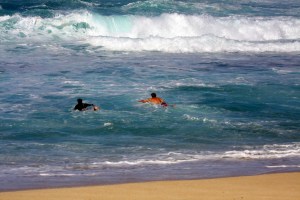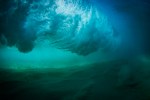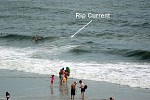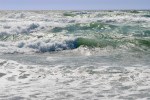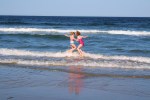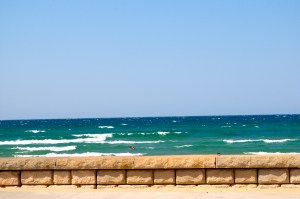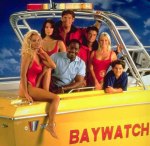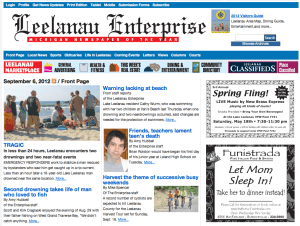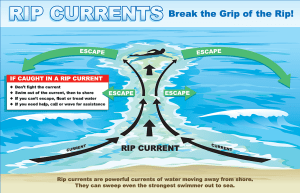It was Delaware, early morning, sometime around 1969 or ’70. We went down to the beach for one last swim before leaving back for Illinois after several days of staying in these little cabins that my uncle, an Army officer, had gotten for our two families. I wish I knew the name of this place.
My mom and aunt spread big blankets out on the brown sand and started unpacking some breakfast, and I headed out into the water. I loved to swim through the waves, go far out, past the breaks, where I could float and feel the power of the ocean under and all around me. I was, still am, a very strong swimmer, and loved the water way more than the  land. I don’t remember if my brother or cousins swam out with me. I don’t remember how long I’d been out. All I remember is this:
land. I don’t remember if my brother or cousins swam out with me. I don’t remember how long I’d been out. All I remember is this:
When I tried to swim back toward land, I couldn’t. I had simply turned to my left to swim back, and couldn’t. The water felt different. I pushed hard into it, but instead of getting closer to shore I was going further out. I had no idea what was happening. I tried waving my arms and yelling at my family on the beach, but no one seemed to see me. They were getting so far away, anyway, I doubted they could hear me. I started getting scared. Tired. I decided to float, so I could rest. I did not know what a rip current was, but I did know that panicking in the water was a bad idea, and that I could float forever if I needed to. Get some energy back, then try to swim in again.
I don’t know how long I floated on my back. I do remember feeling, as I was floating there halfway to Iceland, very disappointed that my family didn’t notice something was wrong.
When I looked around again I was very far out. I tried to swim again, but the current still wouldn’t let me swim back. I could barely see the little group on the beach. I could see, though, that the shoreline was curving in here, on the north, like the top of a crescent. And that part was closer. So I tried to swim that way, to my right instead of left, and — I’ll never forget the feeling! I moved through the water! I could go! So I went. I swam all the way to the top of the crescent. The water was friendly again. I made it to the shallows and stumbled onto the shore. I couldn’t believe I’d made it all that way! Everyone was going to be so happy I was ok! I was really tired, but I was worried about my mother worrying and just wanted to fall into her arms and cry. Plus, I was suddenly so very hungry. I headed back down the beach, around the inward curve of the crescent, exhausted.
Once I spotted them off in the distance it seemed to take forever to reach them. They were dots, then a little bigger, then finally I was there! I ran up to the blanket, to my people, my mother, “I made it! I –,” But no arms reached out. They were packing up. No one was interested in my tale. They hadn’t even noticed I was gone, really. “Come on, let’s go,” was all my mother said.
My heart fell. We all started walking. I was suddenly very cold.

 Not feeling in danger, we continued swimming and began swimming straight out into the ocean. We were all together when I noticed that we were at the end of the fishing pier, which is pretty far out. I mentioned this to my fiance and then realized that my feet were no longer touching the ocean floor. My fiance then said to me “I am being pulled backwards.” That is when panic set in. I tried my hardest to swim away from the currrent but it was too strong. Waves started crashing over me and I couldn’t catch my breath. Just then a wave came and my fiance pushed my son who was on his boogie board towards me. I grabbed the board and was going to try to flag down the lifeguard when, just then, my feet were able to touch the ocean floor.
Not feeling in danger, we continued swimming and began swimming straight out into the ocean. We were all together when I noticed that we were at the end of the fishing pier, which is pretty far out. I mentioned this to my fiance and then realized that my feet were no longer touching the ocean floor. My fiance then said to me “I am being pulled backwards.” That is when panic set in. I tried my hardest to swim away from the currrent but it was too strong. Waves started crashing over me and I couldn’t catch my breath. Just then a wave came and my fiance pushed my son who was on his boogie board towards me. I grabbed the board and was going to try to flag down the lifeguard when, just then, my feet were able to touch the ocean floor.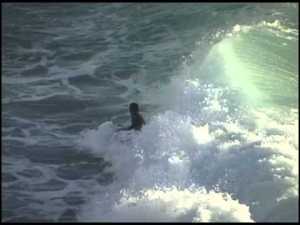
 nue surfing, but our present rip currents may be at an all time high. While I retrieved my board on 1st occasion, my 2nd wipe out separated me from my board, which went onto the beach leaving me boardless. I urge everyone to err on the side of safety, even if one is lifeguard trained, scuba trained, & brought up swimming surfer. I could not swim the seemingly easy 5 yards onto the beach. I could have died had it not been for a young surfer who saw me in distress and shoved my board back to me. Stay with your board on your 1st occasion.
nue surfing, but our present rip currents may be at an all time high. While I retrieved my board on 1st occasion, my 2nd wipe out separated me from my board, which went onto the beach leaving me boardless. I urge everyone to err on the side of safety, even if one is lifeguard trained, scuba trained, & brought up swimming surfer. I could not swim the seemingly easy 5 yards onto the beach. I could have died had it not been for a young surfer who saw me in distress and shoved my board back to me. Stay with your board on your 1st occasion.